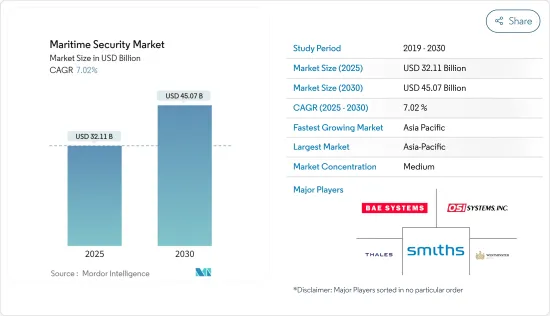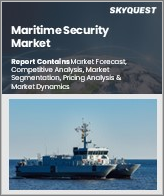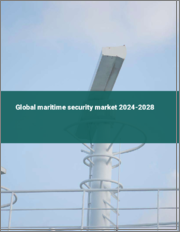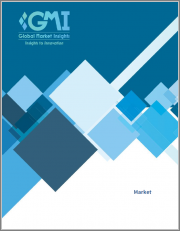
|
시장보고서
상품코드
1686305
해상 보안 - 시장 점유율 분석, 산업 동향, 통계, 성장 예측(2025-2030년)Maritime Security - Market Share Analysis, Industry Trends & Statistics, Growth Forecasts (2025 - 2030) |
||||||
해상 보안 시장 규모는 2025년에 321억 1,000만 달러, 2030년에는 450억 7,000만 달러에 달할 것으로 예측됩니다. 예측 기간(2025년-2030년) CAGR은 7.02%를 나타낼 전망입니다.

국제 전략 상황이 크게 변화하고 있기 때문에 국제 안보 시스템의 구성은 패권주의, 단독 행동주의, 파워 폴리틱스 증가에 의해 손상되어 현재 진행중인 여러 세계 분쟁에 박차를 가하고 있습니다. 2023년과 2024년에 후티 반군의 홍해 지역 상선 공격이 현저히 증가하여 아시아와 유럽 간의 무역에 영향을 미치고 전 세계 주요 군대를 불안하게 했습니다.
이러한 문제를 받아, 선진적인 디지털 플랫폼, 안전한 소프트웨어, 선박 감시 툴의 채용이 진행되고 있어, 이러한 플랫폼의 채용율이 높아지는 동향은 향후 10년간도 계속될 것으로 예상됩니다. 또한, 해상 무역이나 수송 활동 증가에 수반해, 금지 약물의 밀매, 불법 이민, 항만이나 연안 지역에 대한 공격 사건 증가로 인해 악화되어 해상 보안 장비에 대한 수요를 견인하고 있습니다.
한편 해상보안과 관련한 국내법령에 일관성이 없고 시대 지연이기 때문에 거버넌스에 갭이 생길 가능성이 있습니다. 솔루션을 배포할 때 혼동을 일으킬 수 있습니다. 해법 및 시행 프로세스가 국가별로 다르므로 주요 기업이 요구 사항을 준수하기가 어렵고 보안 솔루션을 배포하는 데 비용이 많이 들고 지연될 수 있습니다.
해상보안시장 동향
예측 기간 동안 모니터링 및 추적 부문이 시장을 독점 할 전망
항만과 해안 지역에서의 보안 수요의 높아짐은 고도의 감시 및 추적 시스템의 필요성을 낳고 있습니다. 최근 몇 년간 해적 공격과 강도 사건이 증가함에 따라 라틴 아메리카, 서아프리카, 카리브해 지역과 같은 곳에서 이러한 시스템에 대한 필요성이 높습니다. 한편, 북미와 유럽 국가가 보안 향상을 위해 새로운 해상 감시 기술을 채용하는 한편, 아시아태평양에 있어서의 무역 증가나 해상에서의 긴장의 고조가 감시 시스템 조달의 주요한 원동력이 되고 있습니다.
항만은 어안 카메라, 펀틸트 줌(PTZ) 카메라, 열 카메라 등 다양한 카메라를 배치하고 있습니다.(90도에서 360도) 카메라를 선호합니다. 원거리 감시에서는 해안이나 배타적 경제 수역에서의 어업이나 밀어 등의 불법 행위를 감시하기 위해서 서멀 카메라를 도입하고 있습니다. CCTV 감시 시스템의 입찰을 실시했습니다.이 입찰은 2년간의 보증과 5년간의 종합적 AMC를 포함해, 입찰자에 의한 7년간의 보수를 보장했습니다.
예측 기간 동안 아시아태평양이 가장 높은 시장 성장을 이룰 전망
해상 무역 증가와 항만 인프라 강화에 대한 관심 증가가 아시아태평양 시장 성장을 견인하고 있습니다. 보안 및 감시 시스템의 요구가 높아지고 있기 때문에 항만에서는 미확인의 상품이나 자재의 추적, 이상한 인원이 모였을 경우의 자동 알람, 카메라 위조의 감시 알람 등, 새로운 주변 보안 시스템의 도입이 진행되고 있습니다.
예를 들어 해상보안청은 2024년 6월 일본 해양능력을 강화하고 일본 영해에 침입하는 중국 선박의 문제에 대처하기 위해 다용도 순시선을 개발할 계획을 발표했습니다. 해양 안보에 대한 일본의 헌신을 강조하는 것입니다. 중국, 일본, 호주, 베트남 등의 항만 당국도 해상 보안에 비슷한 투자를 하고 있으며, 예측 기간 중 시장의 성장을 가속할 것으로 기대되고 있습니다.
해상 보안 산업 개요
해상보안시장은 부분적으로 통합되어 있으며, 주요기업은 지휘통제시스템, 감시 및 스캔시스템, 통신시스템 등 다양한 제품으로 시장의 성장을 지지하고 있습니다. 기업은 해상 국경의 전반적인 보안을 향상시키는 새로운 고급 검출 및 감시 시스템의 개발에 많은 투자를 실시했습니다. Safah, Safaniya와 같은 주요 유전의 보안을 강화하기 위해 CCTV를 포함한 통신 및 보안 시스템을 제공했습니다.
기타 혜택 :
- 엑셀 형식 시장 예측(ME) 시트
- 3개월간의 애널리스트 지원
목차
제1장 서론
- 조사의 전제조건
- 조사 범위
제2장 조사 방법
제3장 주요 요약
제4장 시장 역학
- 시장 개요
- 시장 성장 촉진요인
- 시장 성장 억제요인
- 기술 동향
- Porter's Five Forces 분석
- 구매자, 소비자의 협상력
- 공급기업의 협상력
- 신규 진입업자의 위협
- 대체품의 위협
- 경쟁 기업간 경쟁 관계의 강도
제5장 시장 세분화
- 시스템
- 스크리닝 및 스캔
- 통신
- 감시 및 추적
- 기타 시스템
- 유형
- 항만 및 중요 인프라 보안
- 선박 보안
- 연안 경비
- 지역
- 북미
- 유럽
- 아시아태평양
- 세계 기타 지역
제6장 경쟁 구도
- 기업 프로파일
- Saab AB
- Thales
- Leonardo SpA
- Elbit Systems Ltd
- Airbus SE
- BAE Systems PLC
- Terma AS
- Westminster Group PLC
- Kongsberg Gruppen ASA
- Smiths Group PLC
- OSI Systems Inc.
- Nuctech Company Limited
- Leidos Holdings Inc.
- Other Players
- ATLAS ELEKTRONIK GmbH
- ARES Security Corporation
- Rolta India Limited
- HGH Infrared
- HALO Maritime Defense Systems
제7장 시장 기회와 앞으로의 동향
SHW 25.04.29The Maritime Security Market size is estimated at USD 32.11 billion in 2025, and is expected to reach USD 45.07 billion by 2030, at a CAGR of 7.02% during the forecast period (2025-2030).

Because of the profound changes in the international strategic landscape, the configuration of the international security system has been undermined by growing hegemonism, unilateralism, and power politics, which have fueled several ongoing global conflicts. In 2023 and 2024, attacks by the Houthi militia on trade ships in the Red Sea region registered a significant rise, impacting the trade between Asia and Europe and alarming major militaries across the world. These attacks are a result of an escalation of the war between Israel and Hamas militants in Gaza.
Owing to these issues, the adoption of advanced digital platforms, secured software, and vessel monitoring tools has gained traction, and the trend of increased adoption rate of these platforms is expected to continue during the next decade. Moreover, an increase in maritime trade and transportation activities has also been marred by the rising incidents of trafficking of prohibited substances, illegal immigration, and attacks on ports and coastal areas, thereby driving the demand for maritime security equipment.
On the other hand, inconsistent and outdated national laws and regulations related to maritime security can create gaps in governance. These laws are often inconsistent or contradictory, leading to confusion when implementing naval security solutions. Different maritime laws and enforcement processes for each country make it difficult for companies to comply with requirements, which can lead to high costs and delays in implementing security solutions.
Maritime Security Market Trends
The Surveillance and Tracking Segment Expected to Dominate the Market During the Forecast Period
Growing demand for security in ports and coastal areas creates a requirement for advanced surveillance and tracking systems. The need for such systems is high in regions like Latin America, West Africa, and the Caribbean due to the increased number of pirate attacks and robbery incidents in the past few years. On the other hand, while North American and European countries embrace emerging maritime surveillance technologies for improved security, rising trade and growing maritime tensions in the Asia-Pacific have been the key drivers of surveillance system procurement.
The ports deploy various cameras, including fisheye, pan-tilt-zoom (PTZ) cameras, thermal cameras, etc. For comprehensive short-range operations such as monitoring cruise terminal areas, marine ports prefer wide-angle (90-degree to 360-degree) cameras to provide a comprehensive view of busy operation areas. For long-range surveillance, ports deploy thermal cameras to monitor illegal activities such as fishing and poaching in the coastal and exclusive economic zones. For instance, in February 2024, the Cochin Port Authority issued a tender for 36 IP CCTV surveillance systems across various locations. The bid, which encompassed a two-year guarantee and a five-year comprehensive AMC, ensured seven years of maintenance by bidders. Such developments are expected to drive the market during the forecast period.
Asia-Pacific Expected to Witness the Highest Market Growth During the Forecast Period
Increasing maritime trade and a growing focus on enhancing port infrastructure drive market growth across Asia-Pacific. To cater to marine trade in the region, investments are being made into developing new ports and terminal expansions. Due to the increased need for security and surveillance systems, ports are introducing new perimeter security systems for tracking unidentified goods and materials, automatic alarms in case of an unusual gathering of personnel, monitoring alarms for camera tampering, etc.
For instance, in June 2024, the Japan Coast Guard (JCG) announced plans to develop a versatile patrol boat designed to enhance the country's maritime capabilities and counter the issue of Chinese vessels encroaching into Japanese waters. The vessel, set to house three helicopters and a fleet of high-speed rubber boats, underscores Japan's commitment to maritime security. Port authorities in China, Japan, Australia, and Vietnam, among others, are making similar investments in maritime security, which are expected to propel the market's growth during the forecast period.
Maritime Security Industry Overview
The maritime security market is semi-consolidated, with key players supporting market growth with various products like command and control systems, surveillance and scanning systems, and communication systems. Some prominent players are Thales, BAE Systems PLC, Westminster Group PLC, Smiths Group PLC, and OSI Systems Inc. Companies are investing highly in developing new and advanced detection and monitoring systems that will improve the overall security at maritime borders. For instance, in September 2023, Eurocontrolli secured four contracts from Saudi Aramco, supplying telecom and security systems, including CCTV, to fortify the security of key oilfields like Qatif, Marjan, Abu Safah, and Safaniya. Such strategies by companies would help market players increase their sales and profits and expand their businesses to new geographical locations.
Additional Benefits:
- The market estimate (ME) sheet in Excel format
- 3 months of analyst support
TABLE OF CONTENTS
1 INTRODUCTION
- 1.1 Study Assumptions
- 1.2 Scope of the Study
2 RESEARCH METHODOLOGY
3 EXECUTIVE SUMMARY
4 MARKET DYNAMICS
- 4.1 Market Overview
- 4.2 Market Drivers
- 4.3 Market Restraints
- 4.4 Technology Trends
- 4.5 Porter's Five Forces Analysis
- 4.5.1 Bargaining Power of Buyers/Consumers
- 4.5.2 Bargaining Power of Suppliers
- 4.5.3 Threat of New Entrants
- 4.5.4 Threat of Substitute Products
- 4.5.5 Intensity of Competitive Rivalry
5 MARKET SEGMENTATION
- 5.1 System
- 5.1.1 Screening and Scanning
- 5.1.2 Communications
- 5.1.3 Surveillance and Tracking
- 5.1.4 Other Systems
- 5.2 Type
- 5.2.1 Port and Critical Infrastructure Security
- 5.2.2 Vessel Security
- 5.2.3 Coastal Security
- 5.3 Geography
- 5.3.1 North America
- 5.3.2 Europe
- 5.3.3 Asia-Pacific
- 5.3.4 Rest of the World
6 COMPETITIVE LANDSCAPE
- 6.1 Company Profiles
- 6.1.1 Saab AB
- 6.1.2 Thales
- 6.1.3 Leonardo SpA
- 6.1.4 Elbit Systems Ltd
- 6.1.5 Airbus SE
- 6.1.6 BAE Systems PLC
- 6.1.7 Terma AS
- 6.1.8 Westminster Group PLC
- 6.1.9 Kongsberg Gruppen ASA
- 6.1.10 Smiths Group PLC
- 6.1.11 OSI Systems Inc.
- 6.1.12 Nuctech Company Limited
- 6.1.13 Leidos Holdings Inc.
- 6.2 Other Players
- 6.2.1 ATLAS ELEKTRONIK GmbH
- 6.2.2 ARES Security Corporation
- 6.2.3 Rolta India Limited
- 6.2.4 HGH Infrared
- 6.2.5 HALO Maritime Defense Systems














